We think you should have a wide choice of the best gear, so we offer many wings from the top brands. We fly as many of them as often and much we can so we can better advise our customers on which is the right and best wing for them, individually. This gives us a unique opportunity to compare many wings side by side. It also means we can compare how the classes differ, using the latest designs from some top manufacturers. As certification tests change and technology progresses, the character of the wings in each class can evolve. In this article we offer an analysis of the handling differences, and some guidance on how to choose the right class.
Paraglider class divisions
Pilots have different expectations of what the wing categories mean and blindly following the EN ratings can lead to some surprises. We find it useful to define the classes as follows:
First Paragliders
First wings are designed to be accessible for all first time pilots. Bomb-proof handling with often surprisingly good performance. They typically achieve an EN A rating.
Progression Paragliders
Progression wings are designed to be your first upgrade, or for talented students upon licencing (in a mellow flying environment). It's a clear step up from what you can train on, but reassuring and easy to fly with lots of passive safety. Usually get an EN B rating.
XC Paragliders
XC wings focus on handling, security and flying enjoyment. They usually have an EN B rating but are the 'high-B' wings with sharper turns and require some active piloting to keep control. Collapse recovery is low-energy but expect more sporty handling and performance. These are never a first wing; not for new pilots.
Sports Paragliders
Sports wings give you freedom of movement. It's probably where true performance is found for most experienced pilots, this is a sweet spot where handling is still great for thermaling, the wings are resilient in really bad turbulence and glides on half-bar are almost as good as anything in the sky. Usually rated EN C but could include the hottest EN Bs.
Performance Paragliders
Performance wings are focused on XC racing, maximising repeated long glides at speed with the lowest drag possible. For advanced pilots only, these wings with very high aspect ratio and high wing loading are usually challenging to launch, with narrow tips that bring a real risk of cravats during collapses. They demand constant attention and must be flown actively and intelligently. Usually rated EN D but might include a hot EN C.
Competition Paragliders (CCC)
Competition wings is what you buy when you are regularly coming into goal in international competitions and you now want to win. The new CCC wings and the old high-end two-lined EN Ds like the Icepeak 6 would go in here.
Paraglider sub classes
Within each class there can still be a few levels of wings, or wings with unique characteristics that make them unsuitable for particular pilots or environments, so get professional advice before buying anything!
For instance, we've categorised the wings section of our website and split them into levels to try and help you choose wings best suited to you.
Paragliders on paper
Presently, a pilot with a 90 kg all-up-flying-weight has the following choices (some may not be wise!):
|
Class |
First |
Progression |
XC |
Sports |
Performance |
Competition |
|
Wing |
Supair EONA |
Skywalk Tequila 4 |
Advance Iota |
Niviuk Artik 4 |
Gin GTO 2 |
Ozone Enzo 2 |
|
Weight range |
80-105 kg |
70-95 kg |
75-100 kg |
75-95 kg |
80-95 kg |
85-95 kg |
|
Flat area |
26.5 m² |
25.5 m² |
26.0 m² |
24.5 m² |
22.9 m² |
20.3 m² |
|
Aspect ratio |
4.8 |
5.2 |
5.5 |
6.1 |
7.0 |
7.6 |
|
Proj. span |
8.9 m |
9.1 m |
9.2 m |
9.7 m |
10.2 m |
9.7 m |
|
Line length |
6.5 m |
6.75 m |
7.5 m |
7.5 m |
7.5 m |
7.7 m |
|
Cells # |
41 |
45 |
59 |
63 |
65 |
101 |
First paraglider: Supair EONA
The latest First wing from Supair, the EONA, is designed to be forgiving enough for student training but also have enough handling and performance to allow low airtime pilots to enjoy their development after licencing. One thing you cannot see on the specs is the camber, the curvature of the leading edge and the depth of the cells. This makes a huge difference to the character of a wing. The bigger the curve, the more lift it generates at low speed, and the more drag you get at high speed. If you're not concerned about your performance on speedbar and you are happy to just take in the scenery from the air, this is all you need. The EONA features a friendly profile with nice wide cell openings for easy inflation.
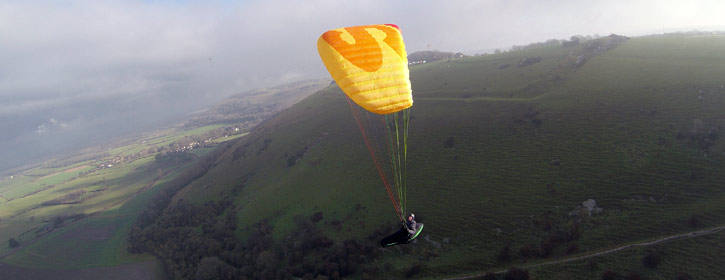
Progression paraglider: Skywalk TEQUILA 4
The step to the Progression class can be subtle, when compared to some modern First wings. But something like the Skywalk TEQUILA 4 has too much freedom of movement and fast responses to be left in the hands of a beginner, yet for a pilot wanting to leave the hill and go explore the wonders of cross country, it's a pleasure to fly and confidence building.
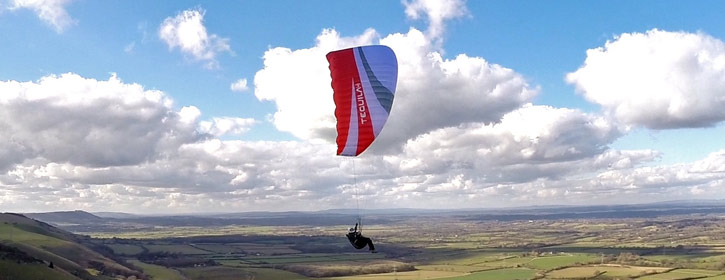
XC paraglider: Advance IOTA
Moving up to the XC class Advance IOTA, you'll notice the line length is a metre more than the EONA. This means you can accelerate the wing to a higher speed during your pullup, so it helps in light wind launching, but also increases the power when ground handling in strong wind. It reduces the pitching angle that results from a pilot flying into lift, so the wing can have a less dampened profile that yields more performance. Other clues to its performance oriented design are the many more cells in the wing, and the narrower cell openings. Due to the limited aspect ratio and low wing loading, XC class wings can often turn tightly and have an edge in climbing in scrappy punchy thermals.
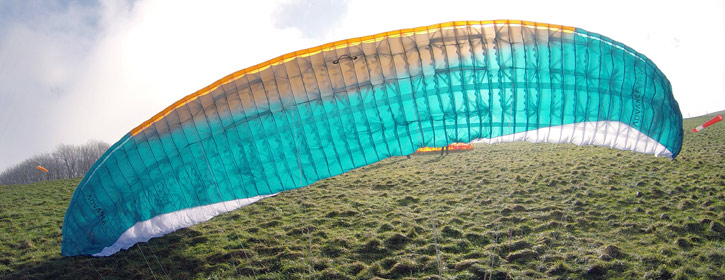
Sports paraglider: Niviuk Artik 4
The step up to the Sports class Niviuk Artik 4 leads to a big reduction in wing area, so the wing loading is higher and you should go a bit faster. The higher speed produces more lift, which balances the higher sink caused by the wing loading, so you should perform equally in thermal climbs, but do better on glides, especially into wind. The line consumption is very low on this wing, as it has only 2 main lines per side. Aspect ratio and cell count have crept up. Performance Class wings usually have the best all-round handling, they feel wonderful to fly and are great for wingovers and swooping around. However, they are more difficult to control because they can pitch, roll and generate a lot more energy than the 'generally mellow' XC Class when encountering prolonged turbulence.
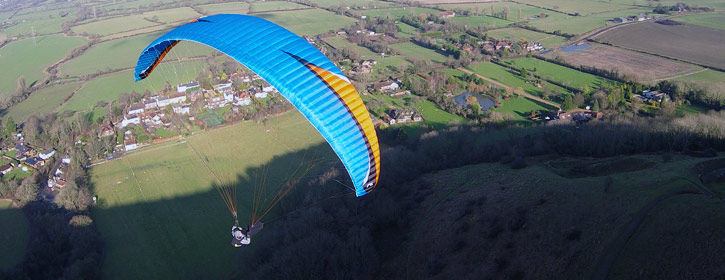
Performance paraglider: Gin GTO 2
Jumping to the Performance class Gin GTO 2, you get over 3 and a half square metres less area than the EONA. But that's not lifting surface ... it's actually got over a metre more projected span, or lift-generating-leading-edge, and that's what counts. The narrow tips also reduce the drag when compared to the large tips of the first wings. What catches most pilots out on the advanced wings is the way the tips can stall rapidly, especially in tight thermal turns. Although the GTO 2 performs very well in its class in this regard, when compared to the lower classes there's a sharp contrast. A pilot who upgrades too quickly without a good foundation of SIV skills will most likely lose control of this wing in prolonged turbulence. It doesn't take much brake to keep an advanced wing stalling and spinning. It demands precise and delicate control inputs.
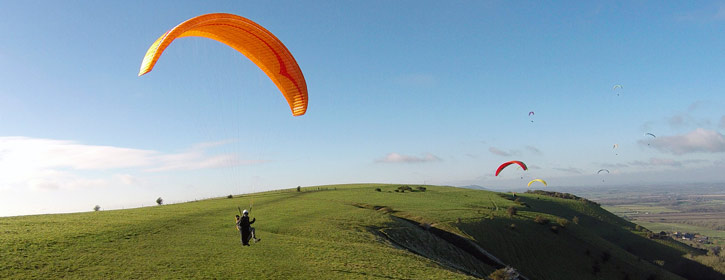
Paragliders in testing
Comparing a few specific aspects in testing: the risers; forward and reverse launching behaviour; ground handling (kiting) characteristics; and the stall point.
Risers
The risers are similar across all classes with 3 main riser sets: split As for big-ears; narrow black webbing, three-to-one speedbar gearing, mini-maillons, and unsheathed lines (except on the First and Progression wings).
Forward launching
In our comparative tests done in a steady 10km/h breeze, the First wing popped up quickly and waited overhead. The Progression wing tracked straight. The XC wing went through a short stall phase where it rotated, before accelerating to slightly ahead of the pilot. It required a touch of brake to control. The Sports wing was less forgiving of a skew layout, it rotated and surged more, requiring more precise pilot reaction. The Performance wing was unforgiving of mistakes and needed correct technique to yield a smooth launch.

Reverse launching
The short lines and big cells on the EONA made it come up straight without much energy. The TEQUILA 4 has similarly large cell openings and short lines, so launching is very easy. Having a good clean horseshoe-shaped layout is more important on the IOTA. Inflation is not as rapid due to the smaller cell openings, and the long lines result in a higher airspeed over the wing, so it generates more force. This is noticeable on the ARTIK 4, where it is important to move towards the wing during the pullup to reduce the acceleration. The GTO 2 tends to shoot off skew unless the layout is perfect and your timing is spot on. It is harder to correct when it goes skew because at the high angle of attack (half-way up during a reverse), the tips of the Performance wing stall very easily. The wing also surges as it comes up and shoots past the pilot, so needs the most input to reign it in.
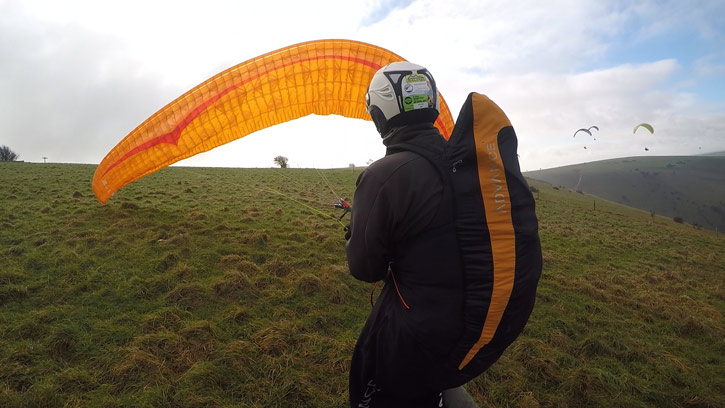
Ground handling (kiting)
The First wing responds quickly and keeps on flying. The Progression wing offered a quick 'pop-up' without the 'pluck' of the higher classes, and gave the impression of being effortless. The XC wing is resilient and allows precise positioning. The Sports wing is also easy but begins to yaw at the extremes. The narrow tips on the Performance wing bend and stall easily, and got stuck a few times in the lines with small cravats. Matching the wing to your skills means you spend less time in the bushes and get more flying. The higher the class of wing, the more time needed to master the ground handling, so if your time is limited it's better to be on the Progression or XC wing.

Stall point
To test this we flew a metre or two above the ground and held the brakes at seat board level. Although it's a lot of brake to fly with, it's probably similar to entering a sudden thermal on your normal landing approach, so it's a good way to analyse how forgiving the wing is.
The EONA really hangs on, it keeps flying at very slow speed, and although it is possible to stall the wing, it takes a long time and happens slowly. The TEQUILA 4 stalls with slightly less brake input, but is entirely predictable. The IOTA provided a reassuring increase in brake pressure and was similarly well behaved. The ARTIK 4 gave a comfortable range, but after a few seconds at low speed was showing signs of wanting to 'kick back' into a stall. Pay attention if you are top landing, or it's turbulent. The GTO 2 does not like flying slowly when compared to the lower classes. Within the Performance class it's fine, but this means you have at most three seconds of deep brake before the wing will disappear in a stall. Reduce that time if you are top landing in lift, or trying to squeak it in behind some trees on a slope.

Matching wings to hours
The class of wing makes a big difference to your safety on launch. Sites are not always perfect, but you can make your launch more forgiving by choosing an easier wing. Although you can step onto the lower end of the Progression class straight out of flying school, the XC class wings like the IOTA, CHILI3 and MENTOR 4 only become suitable once you have 50 hours of incident-free thermic airtime. (If you're only doing coastal ridge soaring, double the airtimes listed here). When progressing to the Sports class we'd recommend at least another 50 hours of thermic flying and some SIV experience. For a Performance wing like the GTO 2, another 100 incident-free thermic flying hours, a full SIV course and a minimum of 100 hours flying per year. Many pilots recognise the improved resale value of XC class wings, so never upgrade beyond that point. Unless you are flying into-wind tasks or competitions, there is little to gain by leaving the XC class.
Paragliders in the air
Although it's tempting to try and compare performance, it's pointless unless you're at matched wing loadings and in completely still air, with at least 1000m of altitude to waste. What's most important is that everyone in our comparison tests enjoyed their flying at the same site, and differences were so small we had to strain to see them. We could not show anything definitive on a video, although you can probably notice the First wing at the bottom/behind and the Advanced wing at the top/ahead of the stack.
In flight: First paraglider
The First class EONA is the most secure wing, it just cruises along and doesn't disturb the pilot. It gives an easy turn without any residual energy to manage. For most pilots who just want to enjoy the scenery from aloft, the EN A does a fantastic job. It makes flying very simple.
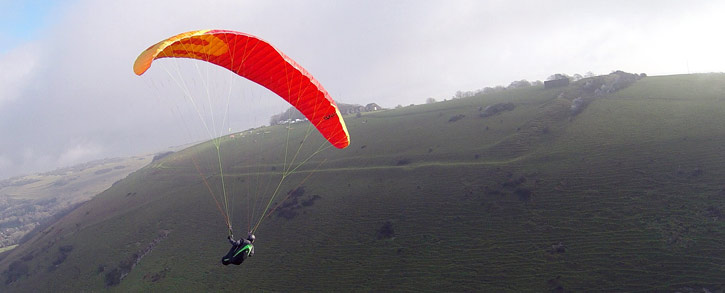
In flight: Progression paraglider
The Progression class TEQUILA 4 is a really fun wing, responsive and playful, and surprisingly easy to build up energy with synchronised turns. It softens the turbulence during glides, turning sharp bumps into rounded thumps.
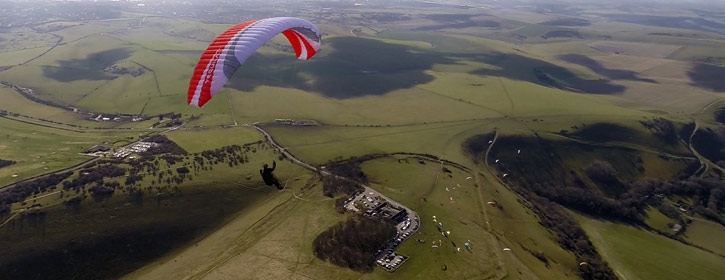
In flight: XC paraglider
The XC class IOTA is not a beginner's wing. The sleek aerofoil is tensioned and efficient, but it surges more as it encounters updrafts and converts speed into height. It looks superb and offers a crisp responsive turn.
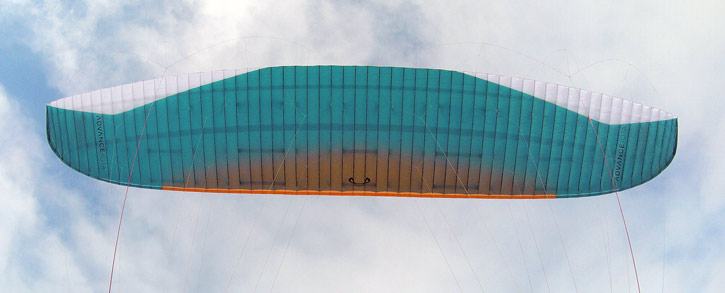
In flight: Sports paraglider
The Sports class ARTIK 4 turns best in a slightly wider arc, due to higher aspect ratio and speed. When it is kept flat in light conditions it is very efficient and climbs fast. It is a high-performance wing with a forgiving nature. I was totally comfortable hanging off the side with a camera and letting the wing sort itself out. It's slightly faster than the lower classes, and is designed for cross country performance. You'll get the best out of it when coring thermals for hours, doing long glides from cloudbase and using the full range of the smooth speedbar.

In flight: Performance paraglider
The Performance class GTO 2 moves all the time, it has a fluid grace. It was always slightly above us during our comparison, floating better, gliding further, converting every little bump into lift. It's more efficient at everything. Watch out though, fluid grace can become 'in your face' in turbulence, so it's stupid to climb onto one of these unless you've mastered all the extreme manoeuvres and you're basically living in the sky. For the right pilots, the GTO 2 offers precise handling, full feedback and that wonderful feeling of freedom. It retains energy in the turns. This means it speeds up as you turn, which can be disconcerting if you're trying to place yourself in a narrow top landing area. As you exit the turn, the speed gets converted into height again. This is very useful if you can deal with it, offering fly-on-the-wall style uphill landings, and the ability to re-enter thermals without losing much in a searching turn.

Big ears (descent technique)
First class EONA has relatively small 'ears' when inducing the big ears descent technique, and a very stable wing.
Progression class TEQUILA 4 makes larger ears and sometimes tries to reinflate when accelerated.
XC class IOTA gives a bigger descent rate and is a little more active but still simple to manage.
Sports class ARTIK 4 produces bigger ears than the IOTA–due to having only two A lines per side there's a bigger chunk of wing gone–and my wingtip caught in the lines and needed more fiddling to clear.
Performance class GTO 2 requires the pilot to care of the flapping tips! Once settled, the manoeuvre is pretty stable.
Which paraglider class? Conclusion
Whatever you are flying, be sure it's something you trust in all conditions, so you can spend as much time as possible in the sky with your friends.
We hope this article and accompanying video (see below) help you understand your choices. Match the wing to your skills.
If you need expert assistance when choosing your new wing we're always here to help.
Check out the great range of wonderful wings we have to offer on our website.
How to Choose the Right Paraglider Part One: Which Class? video
Brought to you by Flybubble
Like what we do? The best way to support us is to buy gear from us. Also recommend us and be a patron. Thank you!

